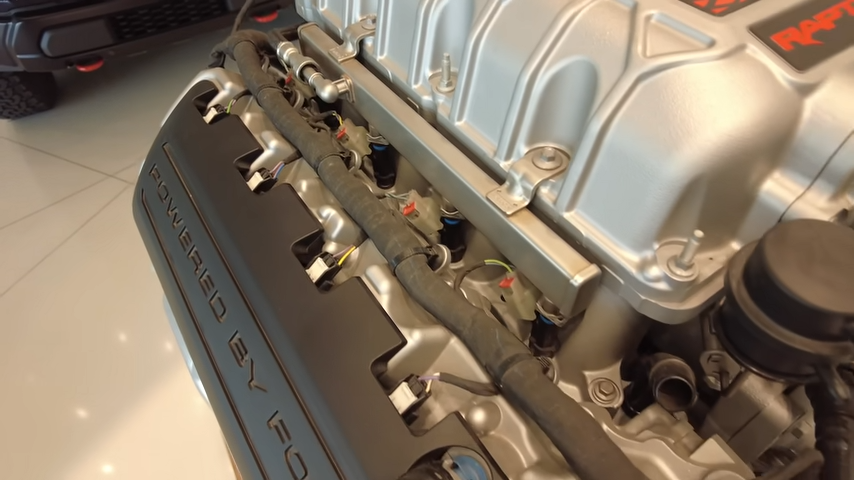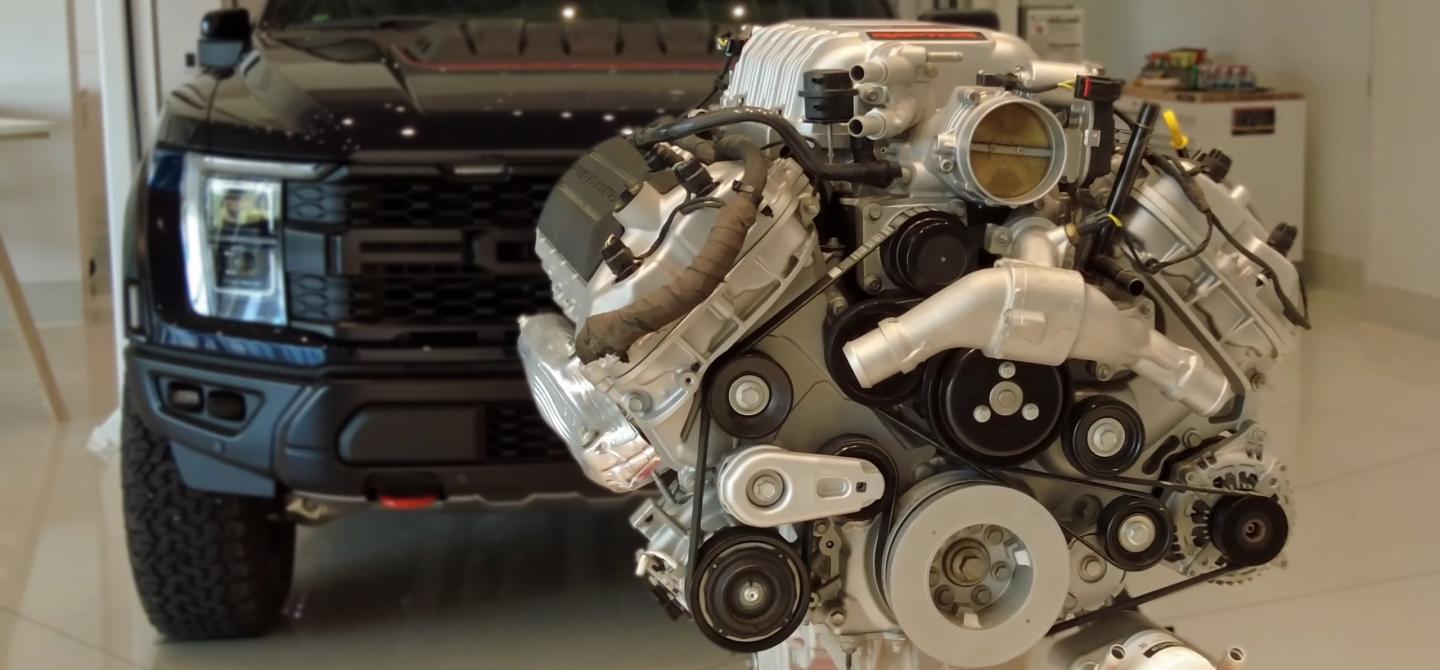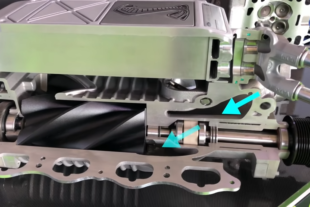In Jason Fenske’s recent video on Engineering Explained, he gives us a pretty thorough look at the new Raptor R engine, which is based on the GT500 supercharged 5.2L. But it’s different, a lot different, yet still, sort of the same.
With all of the EV announcements grabbing headlines these days, Ford is swimming upstream by launching a new internal combustion engine into the wild. Even though the Dearborn company says it’s committed to carbon neutrality by 2050, Fenske astutely points out that that means we have 28 years to party!

The new 5.2L GT500-derived Raptor R engine is pretty badass, and the truck isn’t bad, either. It has gobs of torque and plenty of ponies, too. But is it enough to overtake the 6.2L Hellcat in the Ram TRX?
The Start of the 5.2L Story
Ford’s 5.2L originated with the Shelby GT350 where its high revving, flat-plane crank, naturally aspirated V8 engine has evolved to a cross-plane crank and gained a supercharger for use on the Shelby GT500, which significantly increased the power. But for the Raptor R, the engine evolves even further.
The Raptor R is the latest version of the 5,2L engine, with not much in common with the original GT350 engine. All that remains in the new Raptor 5.2L is the intake and exhaust valves. “So, yeah, the valves” Fenske quips. Aside from that, not much else is shared besides the engine block.

While the 5.2L Raptor R is similar to the GT500 and originally appeared in the naturally-aspirated GT350, it is essentially an all-new engine with only the valves in common.
Fenske notes that the aluminum block and heads have additional cooling jackets and additional strengthening, such as the pan rail structure and other enhancements around the cylinder bores and cylinder head, to withstand all that power. And thanks to that big supercharger, the Raptor R makes 700 horsepower and 640 pound-feet of torque.
Fenske also points out that the Raptor R engine is down on power versus the GT500, but it’s up on torque, and the torque is available sooner. This is mostly because the GT500 is more of a track-capable vehicle where high-RPM horsepower is rewarded, thus the 500 rpm higher redline than the Raptor R. Still, 7,000 rpm is pretty rev-happy for a truck, but it still has the kind of torque you want in this vehicle.

One of the new additions to the 5.2L Raptor R engine is the deep oil sump pan. Since it is designed for off-road use, the pan provides plenty of lubrication at all sorts of angles when you’re out “blasting the dunes.”
The Boost Is Loose
While top speed and lap times are not a priority for the Raptor R, the torque curve is shifted lower by using a smaller supercharger pulley. The designers brought the diameter down from 80.1 to 74.5 millimeters for about a seven-percent smaller diameter. This allows the supercharger rotors to spin faster in the Raptor than in the GT500, assuming both engines are at the same engine RPM.
The Eaton TVS Roots-style supercharger is 2.65 liters in volume and compresses the air to about 12 psi, passing it through an intercooler to cool it down before entering the cylinders. Fenske notes that Ford uses a decoupler pulley on the supercharger that ostensibly acts like a one-way clutch to prevent crankshaft backlash from translating over to the supercharger rotors at low engine speeds.

Another addition to the Raptor R is the rather-large Roots-style supercharger with an internal intercooler. The supercharger displaces 2.65 liters of compressed air into the engine for a ton of power and torque at low RPM.
The Raptor R engine also employs Plasma Transfer Wire Arc “spray-in” cylinder liners that Ford’s been using in production since 2011 with the 5.4L supercharged GT500 engine. Fenske says that one of the big benefits of this plasma spray, aside from it being lightweight and durable, is that it allows for more space within the cylinders, thus giving you a bit more displacement versus an iron sleeve.
The Raptor R veers from the GT500 header design and instead uses a cast stainless-steel exhaust manifold for durability, which is the name of the game since it’s a truck application. It also has very tight packaging. The downside of an application like a truck, according to Fenske, is that the exhaust has to travel back a very long distance, which adds resistance, and there’s really no way of avoiding this because trucks are long. “Mostly in jest, I asked why not side pipes like Mercedes does with the G-wagon?
Ford says they want to make sure the exhaust is above the vehicle side rails since it’s an off-road vehicle and the exhaust could get pinched. That nixes side pipes.”

Ford went with a more durable exhaust manifold for the Raptor R, which is made from cast stainless steel.
Unlike the base Raptor’s 3.5L twin-turbo V6, which uses both port and direct fuel injection, the Raptor R is just using port injection. There are two pumps in the fuel tank to quench the thirst of the 5.2L mill, providing plenty of pressure to all eight injectors. The difference here, according to Fenske, really comes down to the turbocharging systems. All of Ford’s EcoBoost turbocharged engines use direct injection. This lets you run smaller turbos and gives you greater effective compression. It also gives you better control of transitions and fuel load. “It’s more efficient, more responsive, and has better power density,” says Fenske.
“But, I mean this is a Raptor R; fuel efficiency isn’t the name of the game,” Fenske adds. “It’s literally designed to use fuel in abundance, not save it. Port injection satisfies the requirements and is fine to use with a lower compression ratio in a supercharged engine application.”

Direct injection is great for some applications, especially turbocharged engines, but Ford decided to go the more traditional route with port injection. Let’s face it, it’s not about fuel mileage with the Raptor R!
The cooling system Ford employs for the Raptor R is of course unique to the application versus the GT500. One change that Fenske points out is the oil cooler is now a part of the engine’s cooling circuit rather than a separate circuit like on the GT500. “The lower radiator hose has a split where some of the coolant flow passes through a heat exchanger where the oil filter screws on, keeping oil temps in check,” he says.
And unlike the GT500, which is a low vehicle designed for track use, the Raptor R makes use of its height and has a deep-sump oil pan. Why the deep sump? “Well, this thing is designed to go off-road,” says Fenske. “And off-road driving can be at all kinds of different angles with various G-forces.”

With the Ram TRX producing only slightly more horsepower, you would think Ford messed up. But the Raptor is quite a bit lighter and produces a better power-to-weight ratio than the TRX.
The Ram TRX does technically have more power, but only slightly, according to Fenske. “It has just two more horsepower and 10 more pound-feet of torque. Why didn’t Ford give the Raptor R another three horsepower for a subtle jab? But with only a two-horsepower difference, we’re talking about less than a third of a percent. The weather forecast will make a bigger difference than that, and also keep in mind engines can be marketed below their true rated power. It seems Ford simply didn’t want to initiate a horsepower war.”
Ford’s focus (no pun intended) was making sure the Raptor R could sing at high revs while blasting dunes as long as the driver desires, Fenske says. “It’s made to crush the off-road world at speeds that would break your Camry to pieces. So while, yes, it’s down two horsepower versus the Ram TRX, it’s also down 400-plus pounds. The Raptor R is carrying around 8.5 pounds of weight for every horsepower versus the TRX’s 9.2, giving it a nearly eight-percent better power-to-weight ratio.”
Some of the other additions to the 5.2L Raptor R is a decoupled pulley on the supercharger to protect against any kickback from the crankshaft. It also helps with the in-vehicle NVH. Ford also upgraded the oil cooler to include a bypass at the lower coolant hose, so the oil temps stay in check. The bigger supercharger also features a different bypass setup than the GT500, so it can produce plenty of bottom-end torque.
Fenske does give the Ram TRX one big advantage. “While it’s carrying around significantly more weight, the price tag isn’t quite as brutal. The V8 Raptor R starts at $109,145, nearly $30,000 higher than the Ram TRX’s starting price.”
Even at that high price tag, Fenske concludes that Ford will likely sell every Raptor R the company makes.





















